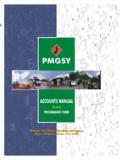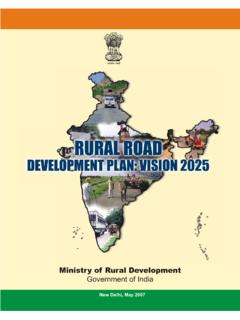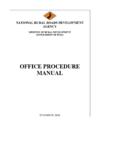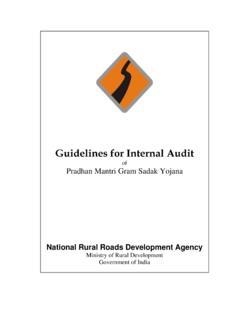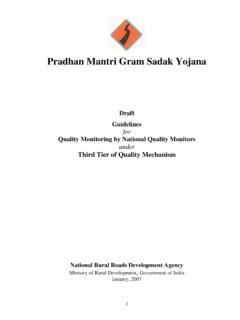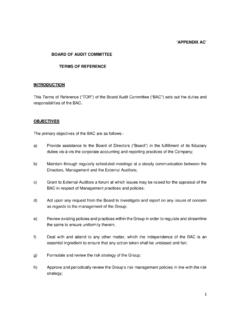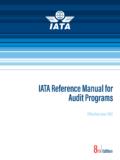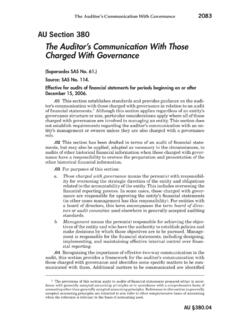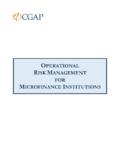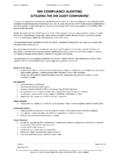Transcription of Guidelines for selection of External Auditors. Final
1 Draft Page 1 PMGSY Rural Roads Project Guidelines for selection of External auditors 1 Objective: The primary objective of these Guidelines is to assist the NRRDA/SRRDAs to select Private Audit Firms (PAFs) having requisite quality, size and capacity to provide independent opinion on the annual financial statements. 2. Background: The legal agreements for the PMGSY Rural Roads Project entered into between the Government of India and the International Development Association (IDA)/International Bank for Reconstruction and Development (IBRD) requires that the project annual financial statements be audited by independent auditors acceptable to the Bank, in accordance with consistently applied auditing standards.
2 Each audit of these financial statements shall cover the period of one fiscal year. The audited financial statements for each period shall be furnished to the Bank not later than six (6) months after the end of the period. Bank-financed operations are required to be audited by an auditor who is technically competent and independent. A technically competent auditor is one who is well established and reputable; experienced in auditing entities receiving development assistance; uses procedures and methods that conform to generally accepted auditing practices; has effective quality assurance arrangements in place; and employs adequate staff with appropriate professional qualifications and experience.
3 auditors of Bank-financed projects should be independent of the entity being audited. The Bank does not accept auditors who also provide consulting services to the implementing. The term acceptable to the Bank requires that express clearance on the name/s of the auditor/s is required to be obtained by the Borrower from the Bank prior to engagement of the auditors . 3. Planning for the Audits: Single Auditor: Each state follow the selection Guidelines and selects a single auditor for carrying out the assignment. The selected auditor shall carry out External audit for all the PIU, SRRDA and the State s consolidated annual financial statements for PMGSY.
4 Multiple auditors following Audit Hub approach: Based on their geographical locations, the PIUs functioning in the state may be grouped together in `Audit Hubs . The PIUs in the state [depending upon the number of PIU's operational in the respective state], shall be divided into hubs; each hub may consist of suitable number (recommended 10 to 15) of PIUs. Separate evaluation process shall be followed for selecting the auditor for each of the hubs. The selected auditor shall carry out independent External audit for all the PIUs grouped under the Hub. Following this principle, one of the auditors may be designated as the `Principal Auditor1 and assigned the task of audit of SRRDA as well as the consolidated State level PMGSY annual financial statements.
5 1 `Principal Auditor means the auditor with responsibility for reporting on the financial information of an entity when that information includes the financial information of one or more components audited by another auditor. Draft Page 2 Role of the Principal Auditor2: When using the work of another auditor, the principal auditor should ordinarily perform the following procedures: (a) advise the other auditor of the use that is to be made of the other auditor s work and report and make sufficient arrangements for coordination of their efforts at the planning stage of the audit; and (b) advise the other auditor of the significant accounting, auditing and reporting requirements and obtain representation as to compliance with them.
6 Other important points of consideration may include the following: The principal auditor should consider the significant findings of the other auditor; There should be sufficient liaison between the principal auditor between the principal auditor and other auditor; The other auditor may bring to the principal auditors immediate attention any significant findings requiring to be dealt with at the entity level, adhering to the time table for audit of the component3; The other auditor should ensure compliance with the relevant statutory requirements. 4. selection Method: selection is made following the `Quality and Cost based selection [QCBS] as per paragraph of the Guidelines : selection and Employment of Consultants by World Bank Borrower, January 2011.
7 This method uses a competitive process among short-listed firms that takes into account the quality of the proposal and the cost of the services in the selection of the successful firm. The Final ranking will done by applying a weightage of 75 percent and 25 percent respectively to the technical financial score of each evaluated qualifying Technical and Financial Proposal and then computing the relevant combined total score for each bidder. The selection process shall include the following steps: (a) Preparation of the TOR; (b) Preparation of cost estimate and the budget, and short-listing criteria; (c) Advertising; (d) Preparation of the short list of consultants; (e) Preparation and issuance of the RFP (which should include: the Letter of Invitation (LOI), Instructions to Consultants (ITC), the TOR, and the proposed draft contract); (f) Receipt of proposals; (g) Evaluation of technical proposals: consideration of quality; (h) Public opening of financial proposals; (i) Evaluation of financial proposal; (j) Final evaluation of quality and cost.
8 And (k) Negotiations and award of the contract to the selected firm. Evaluation and appointment of the project auditor is done following a two stage process the Expression of Interest (EoI) stage and the Request for Proposal (RfP) stage. At each stage, the applicant private audit firms are evaluated on pre-determined parameters. In response to the EoI, audit firms may 2 Reference to SA 600 [AAS 10] Using the Work of Another Auditor [effective for all audits relating to accounting periods beginning on or after April 1, 2002]. 3 Conponent means a division, branch, subsidiary, joint venture, associated enterprises, or other entity whose financial information is included in the financial information audited by the principal auditor.
9 Draft Page 3 indicate their interest in one or more clusters. Separate shortlists will be prepared and evaluation process shall be followed for selecting the auditor therein for each of the clusters. For this purpose, SRRDA constitutes an Evaluation Committee. 5. Roles and Responsibility The primary responsibility for selection , appointment and performance review of the PAF vests with the SRRDA who - a. short lists the applicant PAFs based on Expressions of Interest (EoI) submitted by them; b. evaluates the Requests for Proposals (RfP) received from the shortlisted applicant PAFs; and c. finalizes recommendation and obtain the required approval from the competent authority for the appointment of the selected PAF.
10 6. Preparation of the TOR of the assignment: The Terms of Reference (TOR) for the External audit have been drafted (refer Annexure I) in agreement with the Bank and is included in the Supplementary Operational Manual. 7 Cost of the assignment: Preparation of a well-thought-through time and cost estimate to ensure that (a) realistic budgetary resources are to be earmarked and that the (b) cost is commensurate with the level of effort required for the assignment. The cost estimate shall be based on SRRDA s assessment of the resources needed to carry out the assignment: experts time, logistical support, and physical inputs (for example, vehicles, laboratory equipment).



